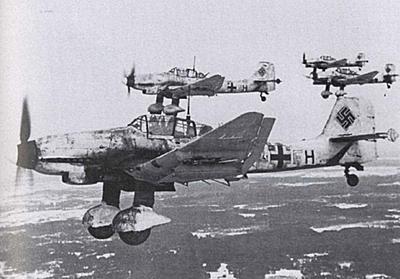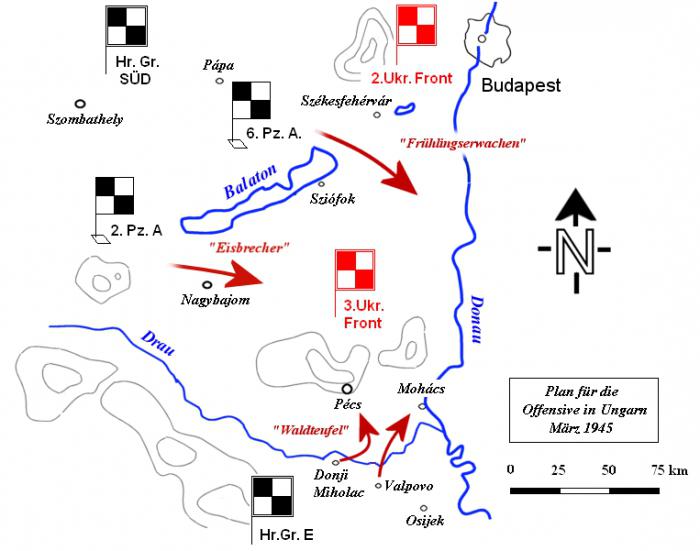The Battle of Balaton: "Spring Awakening"
The Battle of Balaton is considered the last significant defensive operation of Soviet troops in the Second World War. The name of the operation is connected with Lake Balaton, which is located in Hungary.

The Balaton operation was carried out on March 6-15, 1945. In it, part of the 3rd Ukrainian Front was used by the Soviet forces.
The opposing sides
Two main opposing sides took part in the battle: the anti-Hitler commonwealth and the countries of the Nazi bloc. They included allied countries, which supported the main troops.
The Anti-Hitler Coalition | Countries of the Nazi bloc | ||
state | army | state | army |
the USSR | 3rd and 2nd Ukrainian fronts (guards, air) | Germany | Parts "South" and "E", aviation from the 4th Air Fleet |
Bulgaria | 1st Bulgarian | Hungary | 3rd Hungarian |
Yugoslavia | 3rd Yugoslav | ||
Total number | |||
400,000 people, 400 tanks, more than 6,000 guns, 700 aircraft | 431,000 people, 6,000 guns, more than 800 tanks and guns, 850 aircraft, 900 armored personnel carriers | ||
The Battle of Balaton was held with equal opportunities relative to the total number of troops.
Plans of the parties
Germany and its allies planned to holda successful counterattack after the winter of 1945, thereby throwing Soviet troops behind the Danube. In addition, there was only one oil field available to Germany in this area. Without it, the armored and aviation forces would lose fuel.

The German command planned to split the forces of the Third Ukrainian Front in parts, inflicting three blows by tank armies. The operations were called "Spring Awakening".
The command of the USSR received information about plansGerman forces and put the troops of the Ukrainian Front on the task of carrying out a defensive operation, as well as to defeat the enemy near Lake Balaton. At the same time preparations for a march to Vienna did not cease. The Battle of Balaton was the last significant defensive operation of Soviet troops in the Second World War.
Preparation of anti-Hitler troops for defense
On instructions from above, the 3rd Ukrainian Front launchedto defensive actions. At the same time, the experience gained during the Battle of Kursk was used. Defensive work was carried out under the leadership of L.Z. Kotlyar, who was the chief of the engineer troops.

Particular attention was paid toThe tanks, which the enemy had significantly more. To this end, on the section between Gant and Fr. Balaton (83 km), more than 60 anti-tank areas were created, in which the main artillery forces were concentrated.
In many respects the success of the Soviet troops depended ontimely delivery of fuel and ammunition. The front warehouses were located on the other side of the Danube (in the east), so it was decided to build a cableway and a pipeline to transport fuel.
This made it possible to increase the material and technicalbase of troops. Before this, supplies were delivered through the ferries, but it was impossible to rely on them only because of the spring ice drift and the actions of German aviation.
Balaton operation: fighting events

The offensive of the Wehrmacht troops began on the night of March 6, 1945. The first blows were directed at the armies of Yugoslavia and Bulgaria. The attackers succeeded in crossing the river. Drava. They were able to capture two bridgeheads.
By 7 am, the German forces launched an offensive in the next sector (the 57th Army). Further advancement was stopped.
After 1 hour and 40 minutes the enemy went tankarmy to the site of the 3rd Ukrainian Front. This was the main blow of the Wehrmacht, which was inflicted between the reservoirs Velentse and Balaton. By launching massive tank attacks, they were able to advance deeper into the front by 4 km by the end of the day. They also managed to take over Sheregeysh (strong point).

On the morning of March 7, the Battle of Lake Balatonresumed with an attack by the German forces. The command was looking for the vulnerable positions of the defense of the anti-Hitler coalition. At the same time, the Soviet command tried to timely move the available forces to more threatening areas. Within two days the enemy was unable to break through the tactical area, but they managed to get into it at a distance of up to 7 km.
On the morning of March 8, the attackers brought in the main forces. The fights did not abate for several days, during which the Wehrmacht troops were able to break through two defenses. However, this success was not fixed, because on this the lines of defense of the Soviet forces did not end.
Within ten days the enemy advanced on15-30 km, using a large number of tanks. They did not succeed in breaking through to the Danube, but by March 15 their offensive ceased altogether due to the lack of necessary reserves.
The Battle of Balaton became the last significantthe offensive of the German armed forces during the Second World War. Having repulsed the onslaught of the enemy, parts of the Ukrainian front went into a counteroffensive, which was aimed at Vienna.
Losses
The fighting lasted two weeks with the use of various combat weapons, tanks, aviation, so the human losses on both sides were impressive.
On the part of the USSR, 32,899 people were affected, of which 8,492 were killed.
Soviet sources indicate that the Wehrmacht lost about 40,000 people, as well as 300 guns, 500 tanks, 200 aircraft. For them, "Spring Awakening" turned into a catastrophic loss.
results
The Nazi bloc failedset task, while a large number of soldiers and military equipment were lost. His troops were weakened and exhausted, as a result of which the Soviet forces were able to launch a successful offensive against Vienna.
Hungary, the Second World War for which was associated with the plans of the Wehrmacht, was liberated from the Nazi bloc.








